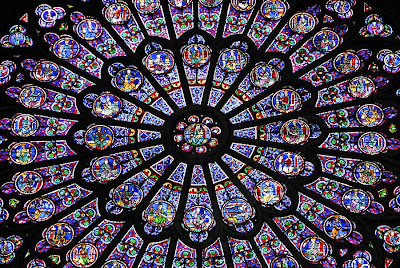She wears her age well, this
Grande Dame :) I'll bet it was built upon an ancient sanctuary of goddess worship. It has all of the hallmarks: It was built on a island (check); it either had it's own source of water or was near a conjunction of rivers (check); it's named after the Roman Catholic Mother of God (check). It incorporates well-known (if not to laymen of today) Goddess symbols ("Rose Window," bells, etc.)
This is the "Rose" Window of Notre Dame Cathedral in Paris. If you count the small circles around the center-most circle in the "rosette," there are eight. Eight, the number of the Goddess from ancient times, as in the eight-pointed rosette symbol of Inanna, back in the days of ancient Sumer. Many "rose windows" also have center-most circles of five, another sacred number codified in the Fibonnaci Spiral and seen in nature repeatedly. See
"Rose Window" at Wikipedia for some great photographs of many different "Rose" windows.
Paris Notre Dame cathedral turns 850 years old
December 24, 2012
By Christian Fraser BBC
News, Paris
She stands in effortless command of
the small island where medieval Paris was re-founded. Centuries of history have
flowed past Notre Dame with the grey waters of the River Seine.
The mighty cathedral is neither the tallest, oldest nor biggest in the world,
but it can rightly claim to be the best-known. For centuries it has witnessed the greatest events in French history: 80
kings, two emperors, five republics - and two world wars. Its famous gargoyles, there to guard against the evil spirits, have faced
both glory and tragedy over the centuries.
The cathedral, with its original 13th-Century rose window, was pillaged and
nearly demolished in revolutionary France.
She survived, and this month sees the start of a year of special events
celebrating the landmark 850th anniversary of "Our Lady of Paris".
Holy wars
The first stone was laid in 1163. It took them 180 years to complete it. Yet
as the magnificent structure took form, history was already playing out in its
shadows. Crusaders prayed beneath the world's first flying buttresses as they
set off on holy wars.
Within the walls, in 1431, a sickly boy of ten, King Henry VI of England, was
crowned King of France.
And in 1804, to the sound of the 8,000 pipes of the cathedral's Grand Organ,
Napoleon was crowned emperor.
Music is integral to the life of the cathedral; in the archive, the medieval
manuscripts reveal it always has been.
Fittingly, then, the great sounds of Notre Dame will be at the heart of the
anniversary celebrations.
Throughout next year, three choirs will bring to life some of the earliest
sounds of Christianity. Choir director Sylvain Dieudonne told me that, "in 1163, when they started
building the cathedral, Paris became a centre of great intellectual, spiritual
and musical development."
Quasimodo's bells
"The musical school was hugely influential," he said. "We know from the
manuscripts we have recovered that it influenced music across Europe - in Spain,
Italy, Germany and in England."
But there is another sound for which the cathedral is well known. The bells
and "the grand peal" that so enthralled the hunchback, Quasimodo.
The biggest of them all is Emmanuel, installed in the south tower in 1685. It
tolls to mark the hours of the day, as it tolled to mark the liberation of the
city in 1944.
But this year, the smaller bells from the north tower are being recast; they
are not the originals. Those were melted for cannon balls by the
revolutionaries. Their 19th-Century replacements were "discordant".
Eight of the bells are being made in Villedieu-Les-Poeles, in Normandy, using
ancient Egyptian methods; the moulds are fashioned from horsehair and
manure. [Ha! There are those pesky ancient Egyptians again!]
"It gives the bell a perfect skin, far better than if you made it with sand
and cement," said Paul Bergamo, the foundry president.
'Best balls bells in France'
"But we are also using a lot of computerised techniques to hone the sound of
the bell.
"We will use a spectral analyser to check the final tone. They will all be
tuned to the great bourdon bell Emmanuel. It's really a mixture of the best
technology - and the best of traditions. And I am confident that when we have
finished this will be the best set of bells in France."
The year-long festival would not be complete without a celebration of the
architecture. And to mark 850 years they will be improving the lighting.
The building was not originally designed to include the flying buttresses
around the choir and nave, but after the construction began, the thinner walls
grew ever higher and stress fractures began to appear as the walls pushed
outward.
In response, the cathedral's architects built supports around the outside
walls, and later additions continued the pattern. Today the cathedral stands as a gothic masterpiece.
In his book The Hunchback of Notre Dame, Victor Hugo encapsulated that power.
"When a man understands the art of seeing," he wrote, "he can trace the
spirit of an age, and the features of a king, even in the knocker on a
door."






































No comments:
Post a Comment